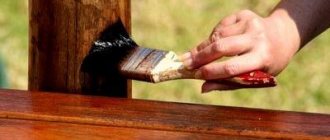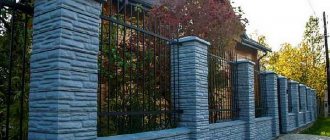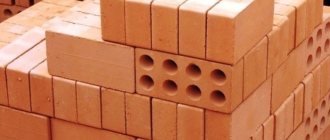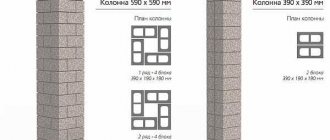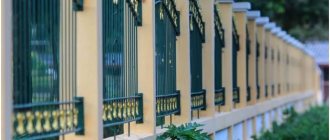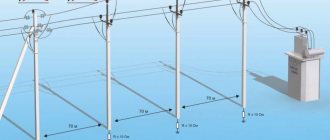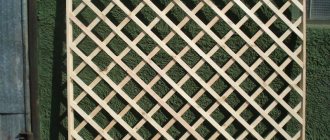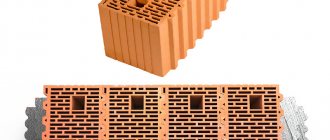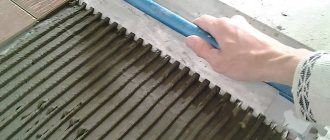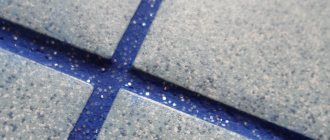Building a durable, strong fence is a serious task. Prefabricated fence posts meet all the necessary criteria.
Finished fence
Modern technologies and materials help solve the main problems:
- the fence must isolate from noise;
- prying eyes;
- unwanted entry of strangers;
- have a good aesthetic appearance.
Having decided to buy just such products for fences, the buyer will make the right choice.
Blocks for fence posts: general characteristics
A vertical structure assembled in the form of a column with a tubular core inside is called a support and is installed on the foundation to ensure the stability of the entire fence. Outside, the load-bearing part of the pillar is lined with decorative blocks made of concrete. Facing elements are characterized by the following indicators:
- dimensions: 25x25x25, 30x30x15, 40x40x20 cm;
- shape in plan - circle, square, rectangle, letter G (when two parts of the element are combined, a cavity is formed);
- the weight of one section is 14-25 kg.
Concrete blocks for fence posts are always made hollow in order to fill the interior space with concrete during installation. The outer surface of the edges imitates the texture and colors of natural stone or brick. The upper part of the inlaid support is covered with a head 130-350 mm high in the shape of a pyramid, ball, or cap to protect it from the destructive effects of rain and snow. Umbrella material: concrete, metal, fiberglass (can be illuminated from the inside).
Conclusion
Due to its special strength, slag material is widely used in the construction of powerful foundations and fences. By the way, these concrete blocks are cheaper than bricks, but, nevertheless, they are no less durable.
High-quality laying of a cinder block fence is only possible with constant checking of the plumb line, level and stretched string. To ensure the durability of this building, we generously apply a high-quality sand-cement mortar to absolutely all cinder block joints. In the video presented in this article you will find additional information on this topic.
Types of concrete blocks
The design of the facing sections of the fence supports can be with or without grooves, a smooth facade or with a texture, angular. The blocks for the pillars also differ in the manufacturing scheme of the stacked racks - there are 2 types of them.
Decorative
Sections consist of two L-shaped parts. During installation, they are stacked in pairs, forming a cavity inside.
Decorative blocks for fence posts are placed over a support pipe or metal core. The operation is performed in stages from bottom to top, followed by filling the internal void with concrete mixture.
Splitter
The first difference between the design and the decorative sections is that the dimensions of the splitter modules are larger. This allows you to quickly assemble block pillars from such elements. The second feature: the typesetting blocks for a fence post of this type are 2 halves of a solid element.
The assembly of racks of elements is carried out in the same way as the decorative sections are assembled. A concrete mixture is poured into the resulting cavity with a bundle of metal reinforcement.
Technological process for manufacturing fence blocks
The raw materials for the production of decorative sections are crushed natural stones. Mixed in the right proportions and placed in molds, they are subjected to vibration and pressure on machines. The components of the mixture for the manufacture of sections are loose aggregates (expanded clay, sand, crushed stone), binding material - cement, dyes, and other additives that improve the properties of concrete.
Vibrocasting
When making blocks for fence posts, the mixture is molded with the addition of water in an amount sufficient to ensure the plasticity and workability of concrete. The forms with the solution are placed on a vibrating table and are not closed; pressing is not performed.
The compaction of the mass occurs due to vibration for several minutes. The block dries in the mold itself, after which the finished product is removed.
Vibration pressing
This method involves preparing a mixture using semi-dry concrete technology: an insufficient amount of water is added to the bulk components to achieve plasticity. The mass is compacted due to two forces: horizontal vibrations of the machine platform and vertical pressure on the mixture from above.
The optimal ratio of components is selected by trial. Finished products are laid out on pallets for natural or forced drying.
Cinder Block Information
Modern high-quality cinder block for a fence.
The material is obtained by vibrocompression of cement mortar poured into special forms. The filler is sand, gravel, crushed stone screenings, brick production waste and even sawdust. As a result, the quality and characteristics of the blocks will differ .
Advantages of a cinder block fence
- Today the price of 1 standard cinder block 190x190x390 is 30-40 rubles. This is lower than the cost of bricks and other analogues. A colored block with a special chamfer is more expensive - 55 rubles. for 1 block.
- It is extremely simple to erect a cinder block fence, and we do not need any special professional skills for this.
- This fencing is absolutely resistant to frost, does not respond to mechanical shocks, and is not subject to fire.
- The durability of the fence will be more than 50 years.
- In the production of modern blocks, environmentally friendly raw materials are used that are safe for humans and the environment.
- The weight of the fence is also advisable: 1 sq. m. such cinder block masonry is one and a half times lighter than any brick.
By the way, we can make a cinder block ourselves, saving money and giving it the necessary properties by specially adjusting the composition and expanding the components of the solution. And the only disadvantages we consider are its hygroscopicity and poor sound insulation.
Advantages and disadvantages
Each of the technologies used for the manufacture of concrete sections gives the product qualities that distinguish vibration-cast blocks from vibration-pressed ones. The former have a smooth surface, but less strength and frost resistance. The latter can withstand a greater number of freeze-thaw cycles and are stronger, but their surface is rough. Both pillar blocks have common advantages in comparison with natural stone and brick:
- Solidity. It is achieved by reinforcing the void and pouring concrete. This design is more resistant to mechanical stress than a support made of brick or stone.
- Quick installation of the pole. The decorative block is larger than a brick, which speeds up installation, but selecting boulders along their edges is a difficult task and takes time.
- Large selection of compositions due to the variety of textures and colors. Posts can be built for any fencing blocks.
- The costs of erecting a fence on supports made of concrete sections are lower than the costs of constructing the same structures from brick or natural stone.
Stacked sections of posts have good compatibility with any fencing materials, be it corrugated sheets, forged metal or wood. Like natural stone, block products last for decades. The only drawback concerns all heavy supports: a foundation needs to be laid under them.
What does it represent?
Aerated concrete block is a material that is obtained from a liquid mixture based on sand and concrete. To create it, simple equipment is used, where a moving mass of ingredients is filled with gas. The result is a cellular material, which is distributed into molds and sent to dry. After freeing the cells, finished gas blocks are obtained.
An aerated block fence can hide the entire area or occupy part of it . Alternatively, the material can only be used as support posts, and the fence itself is made of metal.
When should you build?
A fence made of aerated blocks is suitable for windy areas and dry soil.
According to reviews, such material is often found in Crimea and southern regions . The building material will not be exposed to moisture and will retain its properties longer.
Aerated concrete blocks in the fence design will appeal to those who want to create a stylish fence; with the finishing, such a fence looks expensive.
It is not recommended to use aerated concrete block in cold regions and damp areas. The hygroscopic material absorbs moisture and is destroyed by it, becoming covered with cracks. After the first frost, it will be easy to break part of the structure. It is also necessary to take into account that despite the fact that the gas block itself is inexpensive, finishing materials and pouring the foundation will cost additional money and time.
Requirements
Standard Design Parameters:
- the width depends on the material itself and the method of laying, the average dimensions are 15-25 cm;
- fence height 1.5-2 m;
- the length is equal to the perimeter of the site.
Block cost
You can buy ready-made concrete sections in hardware stores or online. At stands and in supplier catalogs there is always a selection of fence blocks for posts. Their cost depends on the following indicators:
- section dimensions - the larger, the more expensive;
- shape - a circular product is valued higher;
- texture - a brick imitation block is cheaper than a natural stone one;
- brand of cement used to make the concrete mixture for making sections: the binder component of the M500 brand gives greater strength to the solution, the block is more expensive.
A high-quality textured section costs approximately 320 rubles per piece, and a smooth block for a pillar costs 120 rubles. Products are supplied wrapped in film and placed on pallets. The production of decorative sections is not a complex process: you can make artificial stones for fence supports yourself.
Fence installation steps
Much depends on the design of the fence, but in general terms, the step-by-step work looks like this:
- Location determination and marking.
- Digging holes for the foundation.
- Formation of formwork, can be permanent.
- Installation of fittings and mortgages.
- Production of concrete mix.
- Pouring and compacting the monolith.
- Leveling the horizontal surface of the foundation beam.
- Waiting to gain strength.
- Making masonry mortar, or mixing a dry mixture with water.
- Laying blocks.
- Finishing.
- Installing covers.
Technology for installing pillars made of concrete blocks
The construction of the fence begins with markings: the installation points of the support posts are marked on the ground. Depending on the design of the fence fabric and the properties of the soil, the type of foundation for fence posts made of blocks is determined. The final stage is the installation of inlaid supports. All work can be done manually, without the use of construction equipment.
Construction of a columnar foundation
A hole under the base of the stand is dug below the freezing level of the soil by 20-30 cm to prevent movement of the support when the soil heaves. The depth of the excavation does not exceed 1.5 m, and the plan dimensions are taken according to the dimensions of the block plus 50-100 mm. When the pit is ready, proceed as follows:
- 30 cm of sand and gravel are poured onto the bottom of the pit and compacted, after watering with water;
- a pipe Ø60-80 mm is driven into the center of the excavation, the above-ground part - along the planned height of the pillar;
- the pit is filled with concrete, compacting each layer.
For large volumes of excavation work, a excavation in the ground is made with a hole drill.
Strip foundation device
A more powerful foundation will be required when constructing a fence made of concrete blocks. A ditch for it is dug along the entire perimeter of the fence, its depth is 50 cm, and the width is determined by the size of the section of the type-setting pillar with an allowance for the strip foundation formwork. Concreting is carried out in the following order:
- They pour a cushion of sand and crushed stone along the bottom of the trench and line its sides.
- The ditch space is reinforced with the release of rods above ground level to tie the lower row of span blocks. The pillar cores are made from pipes or bundles of reinforcement and are brought to the design height of the fence.
- Concrete is poured.
After the foundation hardens, they begin to install the support blocks and lay the spans.
Features of the device of a strip-column base for pillars
We are talking about a combination of the first two types of foundations. Differences in technology appear already at the excavation stage. The features are:
- Along the bottom of the dug trench, in the places of future pillars, depressions are made for another 1 m. The principles for calculating the size of the excavation in plan and the equipment of the pit remain the same.
- Reinforcement begins with the installation of cores of stacked supports.
- Concreting. First of all, fill the recesses under the pillars with the mixture.
Further actions are carried out using the technology of constructing a strip foundation.
Installation of pillars
Installation of prefabricated supports is done in the warm season to prevent freezing of the cement mortar. The concrete base acquires sufficient strength a week after pouring. Pillars are assembled from blocks by stringing sections onto a pipe. In this case, the core remains in the column cavity. The process is like this:
- Lay out 3-4 rows, align them relative to the plane of the fence and level.
- The internal space of the blocks is poured with concrete, the mixture is compacted, displacing air from the uneven areas.
- The bundle is reinforced horizontally to the backfill mesh or rod.
The cycle is repeated until the full design height of the support is reached. Finally, a protective cap is installed on top.
Finishing work
Vitaly Kudryashov
If you purchased autoclaved aerated concrete specifically for building a fence, you need to remember its initial humidity, which can be up to 40%. In addition, the material is also wetted during the laying process, so it is impossible to immediately begin finishing.
Ask a Question
If aerated concrete is not autoclaved, it does not have initial moisture, but it still absorbs moisture from the solution, albeit in smaller quantities. Therefore, in the summer, you need to let the fence dry for 3-4 weeks, and if it was built in the off-season, then it is better to wait for the warmth.
We have already mentioned that aerated concrete can be used without finishing - or, more precisely, without a decorative coating. However, there must still be a protective coating. This can be considered a water-repellent composition, which will give the masonry water-repellent properties. This is cheaper than plastering, but the coating will have to be renewed every 2-3 years. Most developers, since they have allocated funds for a permanent fence, prefer to decorate it beautifully.
The options could be:
- Simple plaster with paint coating.
- Decorative plaster. This is an option for those who like “expensive and rich”.
- Cladding made of flexible stone (acrylic tiles).
- Cladding made of natural stone tiles.
- Artificial stone based on fiber-reinforced concrete.
- Combined finishing
All of these types of finishes, except for flexible acrylic tiles, are adhesive - that is, the material is held on the base due to the adhesion of hardening layers (plaster or glue). The surface of aerated concrete is smooth, and it tends to absorb moisture - therefore, it is impossible to carry out such types of finishing without preliminary priming.
Vitaly Kudryashov
To avoid cracking of plaster coatings, fiberglass mesh is embedded in the first (base) layer. The tile covering, of course, will not crack, but it may peel off from the base.
Ask a Question
Therefore, tiles cannot be glued directly to aerated concrete, but a reinforcing layer must first be made, as is the case with plaster.
Upon completion of finishing, the masonry is closed with specially shaped caps.
Do-it-yourself block production
You can look for raw materials for making concrete sections yourself in the vicinity of the fenced area; these can be sand, gravel, small stone chips, broken bricks. You will have to buy cement and molds.
Preparation of concrete composition
The grade of cement is not lower than M400, the aggregates must be dry and free of debris, the water must be clean. Proportions for preparing a concrete mixture for the manufacture of a decorative block of a type-setting support:
- cement - 1 part;
- sand with fine crushed stone - 2 parts;
- plasticizing additive - 0.3-0.5% by weight of cement, pre-dissolved in water.
The mixture is moist, crumbly and should not spread.
Molds for making fence blocks
The concrete mass is loaded into a matrix that has a contour in the form of a concrete block for the fence. To ensure that there is a cavity inside the mold, a void box, a metal container, is inserted. Matrix materials:
- fiberglass - hard and durable;
- PVC - products made from it are inexpensive and provide good quality;
- polyurethane - allows for the application of complex patterns.
It is better to buy molds rather than try to make them yourself.
Basic recommendations for manufacturing
At home, you should use the vibration pressing method - the blocks for the pillars are more durable. Tips for craftsmen:
- follow the recipe for the concrete mixture, add water gradually, mix thoroughly;
- lubricate the working surfaces of the molds and void box with machine oil before loading;
- compact the filled mass with a wooden block, striking the other end with a hammer;
- remove the hollow core upon completion of pressing and disassemble the mold.
The finished block needs to be dried for at least two days, and it will gain its final strength in 28 days. To obtain the desired color, dyes are added to the concrete solution.
Is it possible to build a fence for a private house from aerated concrete?
The low weight and hygroscopicity of cellular concrete often give rise to doubts: whether it is possible to build a fence from aerated concrete blocks, and whether there will be problems with it during operation. Therefore, we will answer right away - yes, it is possible to build. And why not, if they build houses from it?
The main thing is to use for this purpose not thermal insulating blocks, but thermal insulating structural ones. For example, if the density of the block is D500 or less, it must be autoclaved. In this case, aerated concrete definitely has the required strength class B1.5, because non-autoclaved blocks with such a density have half the strength. Yes, the fence does not bear loads from the weight of other structures, like the walls of a house, but is subject to lateral pressure in strong winds. Therefore, it is still better to take a more durable material.
